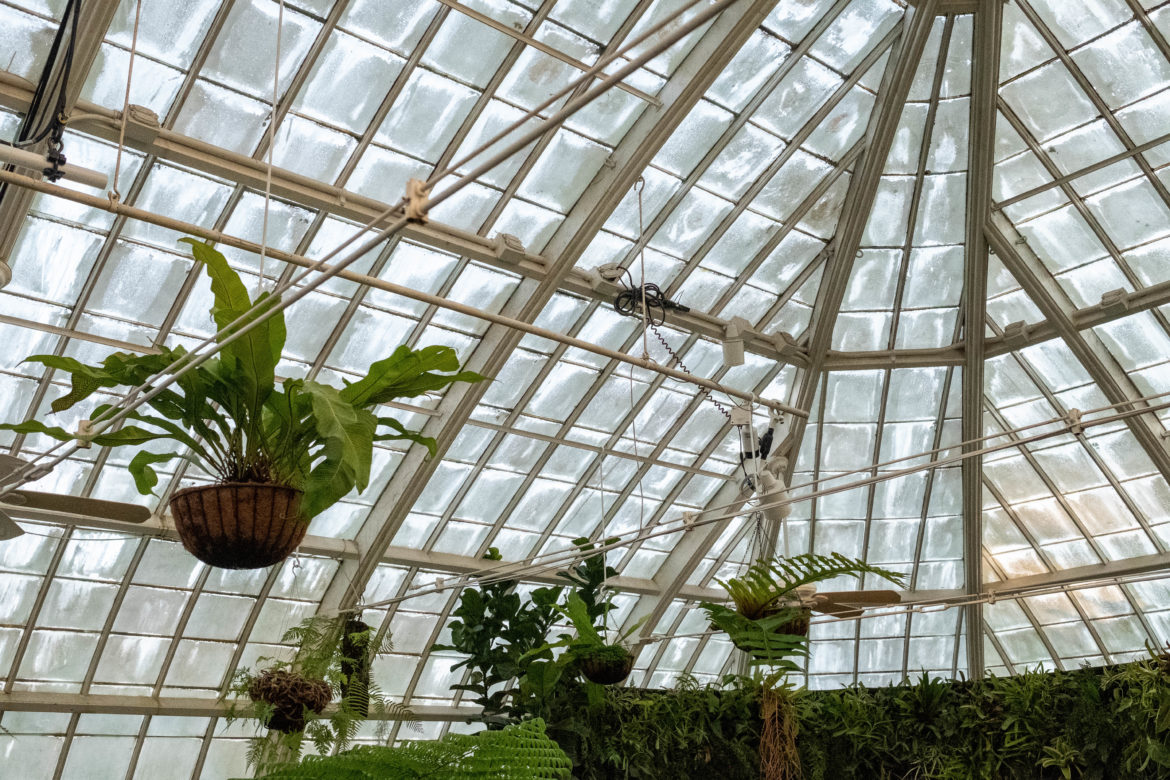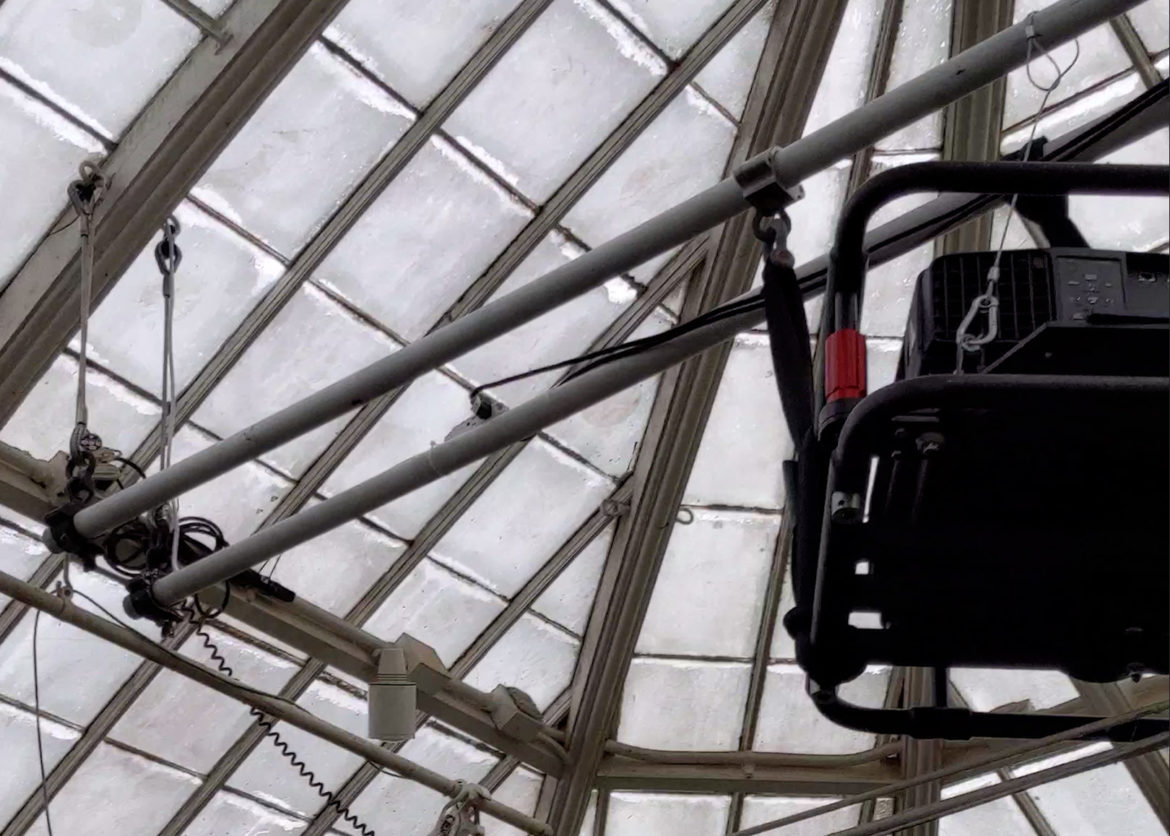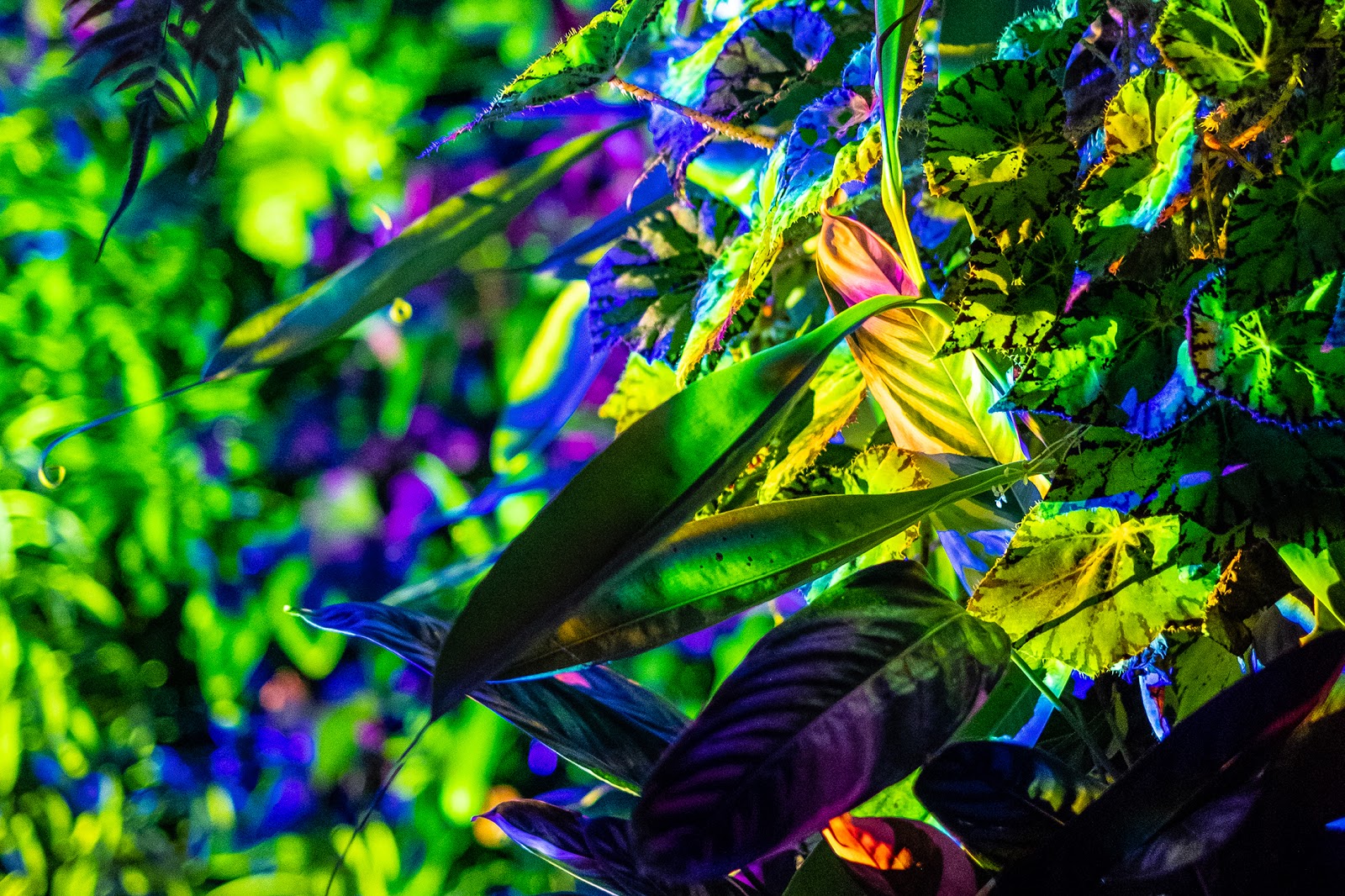It’s no secret here at Lightform – we absolutely love projection mapping on plants. You can imagine our excitement when we were asked to bring our technology to San Francisco’s historic Conservatory of Flowers for their winter light show Night Bloom. Many botanical gardens and arboretums hold holiday light shows during the darkest months of the year, recently some have begun to employ projection mapping alongside more traditional lighting elements.
A few months before the Night Bloom installation began, we brought a 7k lumen Epson G7500 and an LFC beta unit to do some demos and tests in the space. The Conservatory of Flowers has a large outdoor area with manicured lawns, flower beds, and sculptures, but inside its main structure, a sprawling 140-year-old greenhouse, room after room of tropical and subtropical plants thrive. The gift shop at the end of the circuit features a large, lovingly maintained living wall about 3 meters tall and 5 meters wide, which turned out to be our best option for both the simplicity of the mapping and the fact that the watering routine in that particular room was far safer for our equipment.
What we learned in our mid-summer tests as the late afternoon sun came through the greenhouse was that plants absorb light like their lives depend on it, especially the ones with waxy, dark, green leaves. With the projector about 6 meters from the plant wall, we were able to scan and project, but the darker colors of our projection seemed to disappear in the foliage even as the sun dipped below the trees outside. Nonetheless, the botanists who had been tending the plants were excited to see the leaves coming to life and stuck around to watch after their workday was over.
We decided to install our most powerful projector with the LFC Kit on the living wall for maximum effect throughout Night Bloom’s multi-week run. With 12k lumens and a high-contrast 3-LCD laser light engine, the Epson L1505u has done a lot of heavy lifting on many of our large-scale projection mapping projects. With the amount of foot traffic in the gallery, and sprinkler systems just above head height, hanging the projector overhead was the best option for the space. Because the Conservatory’s white-painted glass and redwood greenhouse is a historic structure, there are only a few specified rigging points in the building, and while they’re usually only used to suspend potted plants, they are rated for hanging more than a ton of equipment.

Rigging points above the irrigation system.
Those rigging points were not in the most convenient to place to reach, or in a good spot for our projection angle, so we suspended two lengths of aluminum speedrail pipe from the rigging eyes with aircraft cable, which gave us new rigging point facing the living wall just above everything in the space that could potentially cast shadows. Adding a cage to our big event venue projector brought its total weight to just below 100lbs (45kg), well within spec, and allowed us to hang it from the speedrail using slings and shackles. When rigging a projector for any projection mapping project, rigidity is a huge concern, any movement near your projector will translate to your whole image, so eliminating vibrations and swaying at the source is critical. Hanging a projector from several lengths of cable may seem counter-intuitive, but with enough weight, many points of contact, and the immovable structure of this old building, once the projector settled into position it was incredibly stable.

Tilt controls on our projector’s cage allowed us to adjust the position after flying it.
The living wall, by contrast, was quite dynamic. Dozens of individual plants of all different species, all growing at different rates, being pruned back, or handled by attendees, meant that throughout Night Bloom’s run we had to take a new scan at least once or twice a week. This presented us with a great real-world opportunity to test the Lightform Cloud remote scan and deploy features that we were beginning to develop, not that we didn’t take advantage of the opportunity to work on-site in this beautiful venue from time to time as well.
One of the areas where Lightform Creator excels is in quickly augmenting complex organic textures and creating ambient environmental projection mapping shows. To keep maintenance to a minimum, we created one single surface, a simple vignette mask that covered the entire living wall with a soft feathered border, and let the software’s reactive effects do the rest. We used just about every scan-driven effect in Creator, some of our favorites repeated multiple times with different settings, until we had over 30 slides, each between 30 to 60 seconds long.
That’s a lot of video to render multiple times a week, so we took advantage of the LFC’s ability to run one effect per slide live on the device. This wouldn’t have saved us as much time if we needed to have multiple surfaces and effects on each slide, but when you’re projection mapping onto an intricate and detailed subject, like a living wall, or a mural, a single Creator effect can go a very long way, and it meant that we could take our scans in ideal lighting conditions during magic hour and have the updated show running before Night Bloom’s doors opened in the twilight.
As if that wasn’t a dynamic enough projection mapping situation, we also decided to install a Lightform on a smaller 3100 lumen Epson 1060 home cinema projector and illuminate an operational fountain. A few different species of pond grasses floating on top of the water helped absorb some of the ripples and wavelets from the flowing water. What was not immediately apparent during our tests was that the pond grasses were replenished every few days as they disappeared into the belly of a large Koi named Frank. Not to worry, as Frank gorged himself and the mapped grasses moved out of alignment or through Frank’s GI tract, knee-deep water scattered our projector beam in all directions. The refractions and reflections of our Creator effects as they hit the fountain enhanced the ambiance just as effectively as if they had been freshly mapped.
Every night for six weeks, hundreds of attendees walked through an entirely transformed space created by Lightform and Lightswitch, experiencing colored mood lighting and laser beams interacting with exotic plants in new ways, and for many, experiencing projection mapping for the first time. One particularly enthusiastic child sat themself down in front of the living wall at the end of the exhibit and loudly declared, “I could watch this for hours!” The adults may have shown more restraint, but all generations shared the sense of wonder, and our friends at the Conservatory of Flowers were beyond pleased with the installation and excited to begin expanding the use of projection mapping in their after dark event schedule. See the full video of the Night Bloom event on our Instagram.
~ Sean Servis
Note:
As of August 12th, 2022, Lightform is no longer in business and is no longer providing technical support for the product. Please refer to the Lightform Guide and FAQ for self-help resources.
